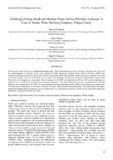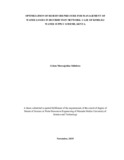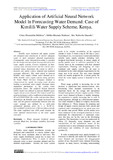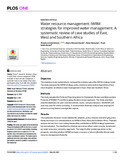Challenges Facing Small and Medium Water Service Providers in Kenya: A Case of Amatsi Water Services Company, Vihiga County
| dc.contributor.author | Kanda, Edwin | |
| dc.contributor.author | Odiero, James | |
| dc.contributor.author | Lutta, Valery | |
| dc.contributor.author | Ong’or, Basil | |
| dc.date.accessioned | 2018-06-20T10:02:42Z | |
| dc.date.available | 2018-06-20T10:02:42Z | |
| dc.date.issued | 2018-01 | |
| dc.identifier.uri | http://ir-library.mmust.ac.ke/123456789/583 | |
| dc.identifier.uri | Https://doi.org/10.22146/JCEF.29263 | |
| dc.description.abstract | The access to water services is a fundamental human right. Water and sanitation services coverage in Kenya is low even with the implementation of reforms in the sector initiated in 2002. Small and medium Water Service Providers (WSP) face numerous challenges which are stifling their ability to sustainably fulfill their mandates without relying on subsidies from state or non-state entities. The aim of this study was to analyze the challenges facing water utilities in rural Counties using Amatsi Water Services Company as a case study. The performance of the WSP was analyzed for 2014 to 2017 and the challenges as depicted were classified into technical and economic parameters. The legal framework was also examined and its possible influence on the operation of the WSP. The main problems affecting small and medium WSPs include high non-revenue water, low metering of connections, low revenue collection efficiency, high operation and maintenance costs, governance challenges, insufficient funding and low quality of service. Furthermore, it is important for legislative clarity on the relationship among the institutions created by the Water Act 2016. | en_US |
| dc.language.iso | en | en_US |
| dc.publisher | Journal of the Civil Engineering Forum | en_US |
| dc.subject | Legal framework, Non-revenue water, Sanitation, Water service regulation, Water Supply | en_US |
| dc.title | Challenges Facing Small and Medium Water Service Providers in Kenya: A Case of Amatsi Water Services Company, Vihiga County | en_US |
| dc.type | Article | en_US |
Files in this item
This item appears in the following Collection(s)
-
Gold Collection [1026]




